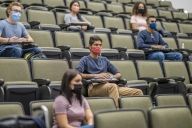You have /5 articles left.
Sign up for a free account or log in.
We tell them, but do we show them how? I’m talking about the academic sources we implore undergraduates to consult. We toss out the word "journal" so often that we could fill one with our own references. We get histrionic about the need for "credible sources," only to read papers culled from search sources that don’t show up on Google Scholar. We rail about the need to consult "experts," but plod through papers with thoughts purloined from pop culture icons and bloggers whose rants are better-developed than their command of fact. We get frustrated. But do we teach undergraduates how to read academic journals, or do we merely assume they should?
Is this the part where I tell you that you didn’t always know how to read a journal? Yes. Remember those days and spend some class time decoding and demystifying academic writing. We hear much about how students don’t read, but I know many who’ve plowed through all the Harry Potter books, devour favored forms of fiction, and spend hours on websites. That’s part of the problem, actually. The first thing we need to teach students is the concept of tone.
Ask students to think about the broader idea of communication, the reasons for it, and how different types of communication demand different styles. Do a quick brainstorm of forms of communication that are appropriate in one situation, but not another. If need be, get as basic as asking students to explain the difference in tone between an e-mail to a friend and a job query letter. Armed with this, move them to consider the link between tone, audience, and purpose. Then spring it -- ask for whom and for what purpose a journal article is written.
Once we establish that academic peers, not general readers, are the intended audience, and that presentation of research, new findings, and new ideas are among the purposes of a journal, we can then query if it makes any sense to read these the way they would approach a Harry Potter book. When the “well duhs!” subside, spend a few moments talking about how it’s just as important to have multiple reading strategies, as it is to write in different voices. Now comes the hard part. How should students read a professional article? I usually emphasize the following:
- Purpose and reading strategy
- Main points and new claims
- Abstracts and introductions
- Habits of the writer
- Evaluating evidence
- Concrete examples
- Small doses
- Skimming and moving on
- Back to the purpose
Students register surprise when I confess that I share some of their frustrations over academic writing. Quite a few scholars are dreadful writers. There is, in my view, entirely too much pretentiousness, jargon, and affected weightiness oozing from journal pages. That’s why the first thing I tell students is to identify their purpose for consulting a professional work. What do they hope to extract? Do they need to learn from the author’s theoretical perspective, or mine the piece for examples? Are they reading it to contribute to a class discussion, or to collect perspectives to use in a paper? These matters determine their reading strategy.
Students are startled to consider that it’s often easier to find the writer’s theoretical and analytical points than to scan content. Quite a few students skip the abstract and pay little attention to the introduction. These, of course, are precisely where most journal writers lay out their theses, outline their main arguments, and make whatever new claims they purport to prove. Tell students that these are the parts of a journal article they should read most carefully.
I advise them to determine the writer’s habits before they worry about content or argument at all. Look for the blueprint. Does the writer preface each section with an overview? Does the article move from example to analysis, or does it do the opposite? Does the writer summarize findings in one section before proceeding to the next? Where are other people’s findings discussed? Is data embedded in the article or does it appear in footnotes or addenda? Learning the writer’s habits is crucial for developing an efficient reading strategy.
Encourage your students to look at the footnotes, even if they don’t read them. This will help them evaluate the author’s evidence. Do they see primary sources, or mostly secondary material? What kinds of things are cited? Knowing this can help students look at the article and determine whether the author’s main points are rooted in concrete examples and evidence, or whether it relies too heavily upon rhetorical jousts, wordplay, and strongly worded assertions. Are the sources credible? More to point, are they sufficient to carry the thesis?
I generally suggest that students take journal reading in small doses. Many readers give up on prose that is obtuse, non-compelling, or non-narrative, which pretty much sums up most journal articles! Again I remind students of the need for different reading strategies. Journals are seldom "stories," so there is no urgency to consume them in a single gulp.
Very little of what I tell students takes them aback as much as when I tell them that it’s a waste of time to read some journal articles verbatim. I encourage them to skim, jot down a few potentially useful ideas, and then move on. In fact, I often tell them to read journal articles with the goal of retaining about as much of it as they would of a book they liked a month after they finished it. I remind them again to peruse the article with their purpose for reading in mind. How much will they need to participate in a class discussion? If it’s for a paper, what will they use? If it’s not much more than a line such as “Rob Weir argues that…” all they need is to find that argument and assess whether I have good reasons for making it.
Perhaps some of you think it’s heresy for me to suggest that students approach research journals so cavalierly. Let me remind you of the importance of audience. I need to read journals carefully and so do you, but most undergraduates do not. Some of them are akin to apprentices learning to approach a new tool for the first time, so let’s not scare them off. Quite a few aren’t even that -- they’re mercenaries fulfilling an assignment and it’s our job to bring them back safely. If, in the process, we decode the secret of journals and students consult them more regularly, we’ll be the beneficiaries of our own good deeds.
A final word: if you have a class of junior or senior majors, your task is different. You need to get those students accustomed to looking at professional journals. I’d still offer much of the same advice, but I'd also give a follow-up assignment and make the class write reviews of the article. I’ve still not found anything that encourages reading with the same urgency as a writing assignment!








